The market for on-demand applications has been gaining more revenue and traction in the last few years. Especially in 2020, the market experienced significant growth when people could not freely leave their homes and lost the possibility to go out for dinner or even to shop for groceries. In 2021, the revenue of the online food industry reached more than $302,826 million and will likely continue to grow.
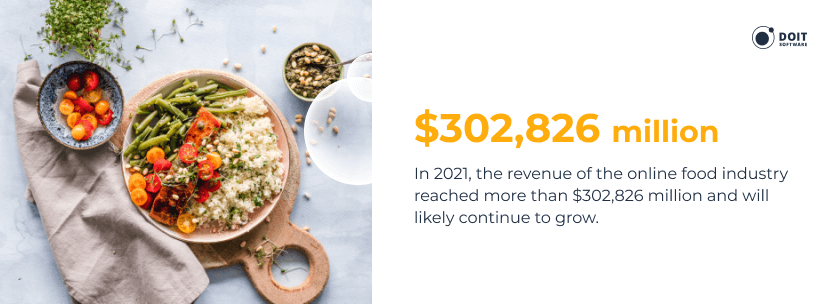
With delivery apps like Uber and GrubHub dominating the market, food delivery app development becomes more challenging and overwhelming. But what is the secret? Is it even possible to create a successful delivery app? In this article, we will investigate the food delivery app development process based on a real-life example and learn the features, tech stack, and costs of a food app like Uber Eats.
Before learning how to develop an on-demand food delivery app, let’s take a look at the top five most popular and beloved apps.
iOS & Android
Number of users: 66,000,000+

Features: Personalized suggestions based on order history, restaurant manager, various filters to find the best offer, operates in 45+ countries
UVP: Eats Pass subscribers get 5% off all orders
Price: Free, delivery fees vary. Eats Pass is $9.99 monthly
iOS & Android
Number of users: 20,000,000+
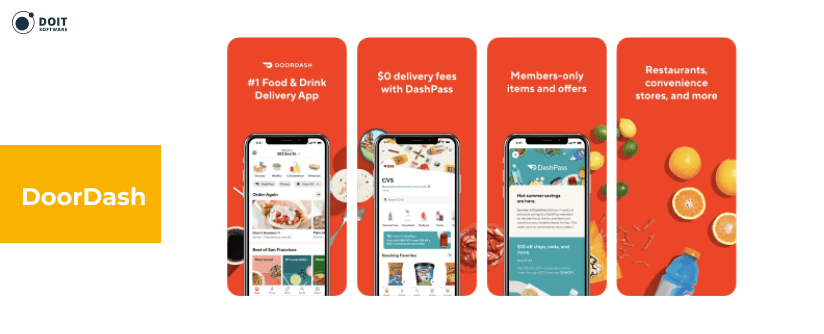 Features: SafeDash feature that keeps couriers protected, suggested restaurant and items based on previous orders, DoubleDash feature that allows customers to order from multiple venues all at once without extra fees
Features: SafeDash feature that keeps couriers protected, suggested restaurant and items based on previous orders, DoubleDash feature that allows customers to order from multiple venues all at once without extra fees
UVP: The first month is free, including the delivery fees
Price: $9.99 per month, delivery fees vary
iOS & Android
Number of users: 5,000,000+
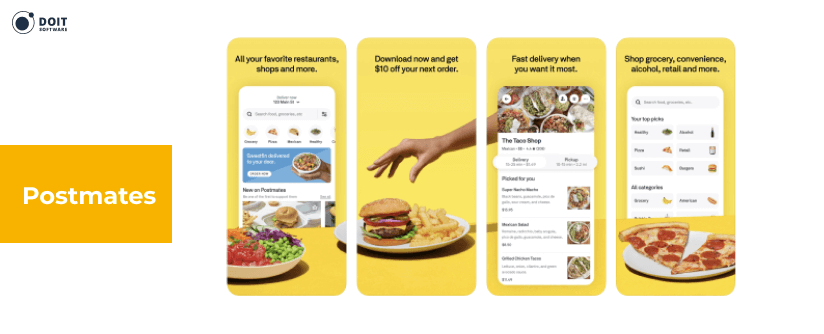 Features: Postmates Party feature that allows multiple customers to order from the same vendor and share delivery fees, curbside pickup feature, option for delivery of office and household supplies, alcohol, medicine, pet supplies, convenience store goods, and more
Features: Postmates Party feature that allows multiple customers to order from the same vendor and share delivery fees, curbside pickup feature, option for delivery of office and household supplies, alcohol, medicine, pet supplies, convenience store goods, and more
UVP: Delivery from big beauty brands and liquor stores
Price: Free, delivery fees vary
iOS & Android
Number of users: 2,000,000+
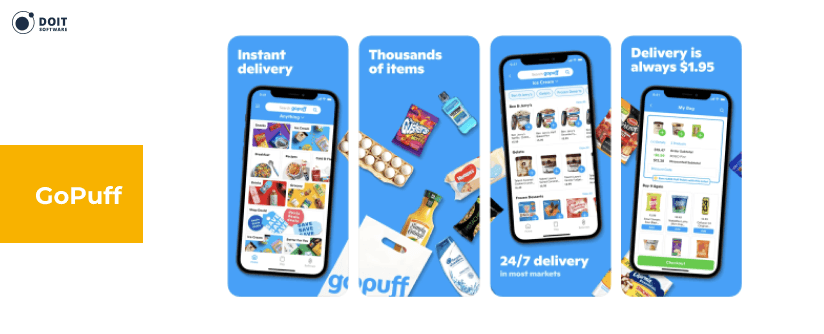
Features: Flat delivery fees depending on the time of the day, GoPuff’s own micro-fulfillment centers and kitchens allow customers to order anything they want from one vendor
UVP: Medicine, electronics, and beauty products delivery
Price: Free, $1.95 flat delivery fees
Selecting a suitable business model is a vital point in the food delivery app development as it directly impacts the product/market fit and determines whether the solution will survive the competition. Recently, the emergence of ghost kitchens has revolutionized the food delivery industry and provides a unique business model option for entrepreneurs to consider.
If you fly too high and go for an aggregator and fail to get restaurants on board, your app will not catch on. Be mindful of your abilities and opportunities and start small as you can always expand later. We will go over two main business models for a delivery service like Uber and explore the benefits and downsides of each option.
The central feature of an aggregator business model is allowing multiple restaurants, stores, and shops to connect to users. This type of food delivery app like Uber provides access to the platform to many businesses and acts as an intermediary between users and restaurant owners. Examples include UberEats, GrubHub, the main Uber Eats competitor DoorDash, and many more. However, the aggregator business model consists of two further categories that we will dive into.
Every app like Uber for food delivery consists of an admin panel, a restaurant side, customer-side, and a delivery service provider. The order and delivery model usually collaborates with a third-party delivery service to ensure that the food reaches the customer. The delivery provider can also set their own fees.
The integrated business model for a food delivery app like Uber allows for external delivery services and restaurant couriers. Many restaurants provide their own courier services or hire a few delivery agents to help them out. This type of app allows restaurants to choose between using the app’s provided delivery services or delivering the food themselves.
The inventory business model is an alternative to Uber Eats like applications that connect users to only one business. The platform admin manages and controls the entire value chain, from operating the app and preparing the orders to completing the deliveries. This type of food delivery app like Uber does not allow multiple vendors to offer their services but only focuses on a primary restaurant. Examples include McDonald’s, Domino’s, and other large restaurant chains.
In this article, we will focus on the inventory business model, the UberEats alternative, that involves only one business that runs the app. The main features include four parts: the client side, courier app, admin panel, and the restaurant owner side.
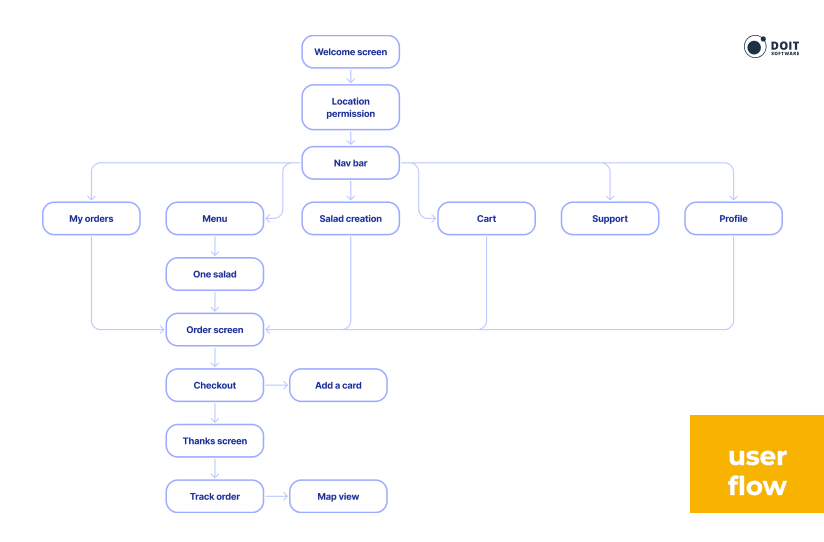
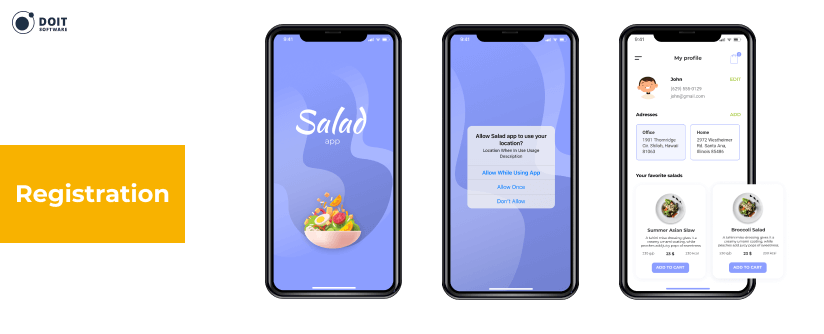
Registration is a feature that allows users to sign up and create an account. This process can be led through email, phone, social media platforms like Facebook, and Gmail accounts. Don’t forget to include email confirmation and password restoration.
Using geolocation, your customers must be able to find the desired restaurant, especially if you have several locations in the area. Allow users to enable their location to see which vendors are closer to their homes and offices.
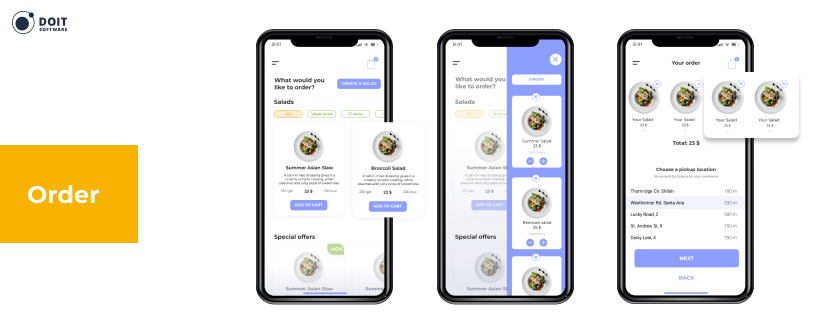
Apps like UberEats should provide an easy-to-navigate menu and shopping cart with checkout. Implement filters to help users find what they are looking for with a product description and price. The shopping cart should entail all the important information, including the total cost, delivery time, and payment methods.
Customers should have an opportunity to select the delivery timeframe to receive the order at the most convenient time.

Make sure to integrate several payment options including PayPal, credit and debit card, Stripe, Apple and Google Pay, etc. Some locations, especially in less technologically advanced parts of the world, still offer cash on delivery.
![]()
After a user has placed the order, allow them to track the courier’s location in real-time. This helps customers gauge how long it will take for the order to arrive, as well as find out about possible delays. Incorporating route management ensures that the tracking is accurate and efficient, providing real-time updates on the courier’s journey.
Alternatively, companies like Uber Eats and others offer a pick-up option that allows users to get their order from the restaurant. Location tracking can also be useful for the self pick-up feature to help customers quickly find the restaurant.
This option is not vital for an inventory business model but preferable. Reviews will help users learn about various dishes that your restaurant provides and form an opinion about the cuisine before ordering.
Customers should be able to access courier’s data like name, vehicle, and phone number to get in touch with them if needed.
Order history should be stored on the client and restaurant side as well as the admin panel to help them recall their previous orders. Maybe a customer ordered something great and forgot the name of the item, and the history will help them find the dish.
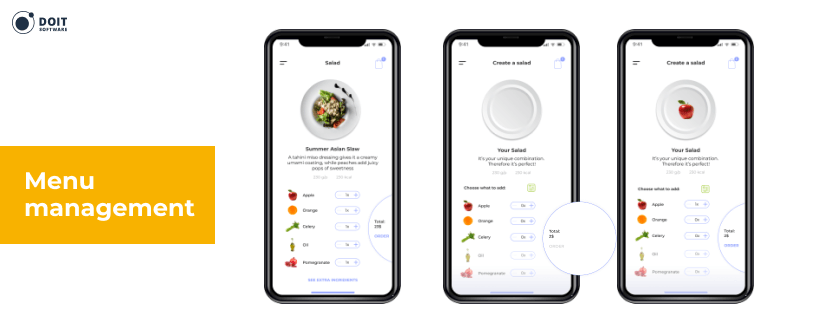
Restaurant owners and employees in charge should be able to add, remove, and edit items on the menu. On top of that, enable the uploading of pictures, descriptions, and prices to complement dishes.
New orders should be easily accessible through the application to accept, decline, or change them. The application should also allow restaurant owners to change the status of the order if necessary.
When it comes to a significant number of orders, it’s better to process them on one streamlined platform. For example, if you’re running a pizza house, your delivery service app can be integrated with your pizza POS system.
This feature involves permission management that allows certain users to conduct various activities.
Analytics is an integral part of every app admin panel as it gives helpful insights into the app performance metrics. This feature allows administrators to keep track of orders, inventory, delivery times, revenues, marketing campaigns, etc.
Admin panel is where the payment methods are stored and managed to ensure a high grade of security and accuracy.
The app administrator should have access to the delivery personnel to assign or reassign orders and ensure timely and smooth deliveries.
Delivery agents also need a signup option to create an account and start working for the restaurant. The signup methods could include email, phone, and social media platforms.
To ensure a high-security level, couriers should be able to create a profile and add personal information. Afterward, the admin can check the profile and verify it once all the essential documents and information are in place.
Allow delivery agents to find the easiest route to the customers by integrating a map into the courier side of the app. Check out the UberEats delivery map to make sure yours looks professional and interactive.
Couriers should also be able to access the information about the order such as delivery address and time, the contents of the order, and the user’s name and phone number.
The Courier side of the app should also include order status updates. For example, when a courier arrives at the restaurant, picks up the order, and leaves to deliver the food, all of these actions should go through the food delivery app like Uber to update the customer.
Additional features are not necessary for a startup but will come in handy in future iterations. They improve customer experience and provide a unique value to users.
To provide an additional layer of security, you can implement two-factor authentication that requires users to use two means of signup methods like a password and a code sent to their phone number.
Notifications allow users to do their own thing while waiting for a delivery and get alerts about status changes. You can let customers know about offers, promos, discounts, etc., through simple notifications. These messages incentivize users to check out the offer and place an order with a bonus or discount.
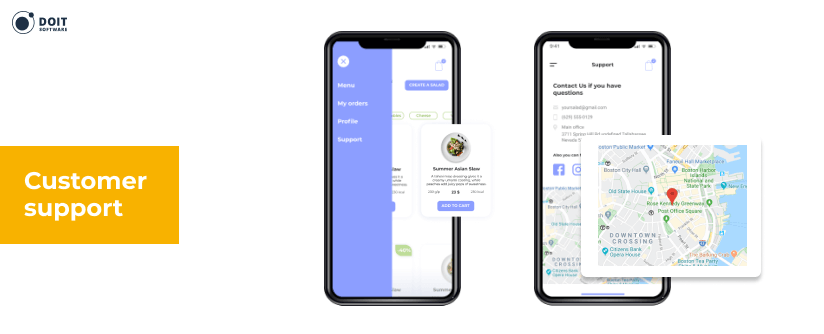
In case of any issue or misunderstanding, a customer can contact the restaurant through the customer support feature to ask a question, file a complaint, or solve any other problem. You can also use a chatbot to streamline customer support operations and provide quick services like UberEats does.
If you have several business locations, provide a list of each one with a detailed address and contact information to allow customers to visit your brick-and-mortar.
The in-built tipping feature helps customers remember to leave a tip and allows delivery agents to earn some extra income.
Based on the order history, your app can suggest similar dishes and beverages to help users make a quick and simple order.
Admins should be able to send out or trigger notifications about discounts and special offers. Allow the admin to create, store, and manage loyalty and bonus programs. It will help to incentivize users to continue using the application.
If you would like to create a solution similar to the UberEats courier app, allow your couriers to set their custom availability. This way, they can work during the hours they find the most accommodating for their schedule.
As you can see from the features list, to create a service like Uber for food delivery, you need to develop a few mobile applications and an admin panel.
The choice of your tech stack begins with the question of native vs. cross-platform food delivery app development. Native app development is on average more expensive than platform-independent but delivers applications with better performance. Cross-platform development is more cost-effective but usually provides slightly lower speed. Let’s take a look at the most used technologies for both options.
Java and Kotlin are two prominent programming languages for Android food delivery app development. Java is one of the oldest languages and provides a wide range of open-source tools and libraries for mobile app development. Kotlin is a relatively new language that is known for being lightweight, flexible, and fast.
Android Studio is an official integrated development environment (IDE) for Android. It comes with code editing, debugging, and a flexible coding environment. The IDE is a favorite choice of Android app developers as it offers more freedom to focus on creating applications with high speed, great performance, and superior quality.
Android Developer Tools (ADT) is a toolkit that offers a variety of debugging tools, emulators, UI builders, and automation features.
Android Software Development Kit (SDK) is a suite of development tools such as a debugger, libraries, emulators, tutorials, and documentation.
The two most prominent programming languages for iOS development are Objective-C and Swift. Objective-C is an older language that enables object-oriented programming and a dynamic runtime environment. Swift is a newer technology that offers dynamic libraries that reduce the app size and improve app performance.
Apple XCode is a toolkit that helps developers create mobile applications. This toolkit allows for debugging, keeping the documentation, and building UIs.
iOS SDK is a set of development tools that give coders access to different functions and services of Apple devices to create advanced applications.
Flutter is a UI software development kit built by Google for creating cross-platform applications for Android, iOS and web operating systems. The SDK provides tools to build native-like apps with increased performance and higher functionality compared to other cross-platform development tools. Flutter is known for its extensive documentation and many widgets. You may also consider other frameworks like React Native or Apache Cordova.
React.JS is a highly efficient JS library for building websites with minimal coding. The advantages of React.JS include virtual DOM and components reusability. This JS library is open-source and constantly evolving and advancing to allow coders to create a food delivery website with high performance.
For the backend (API and Admin Panel), Node.JS makes an ideal addition to the tech stack. Node.JS is a Chrome V8 JavaScript engine based runtime environment that improves efficiency and developer productivity as well as accelerates the speed of development.
The food delivery app development costs depend on the app complexity, vendor’s location, and tech stack of your choice. In our example, we will go over a delivery app like Uber, break down the costs of each development milestone and answer the question “how much does a food delivery app cost?” Below you may find an estimate for the food delivery app based on the Inventory Business Model.
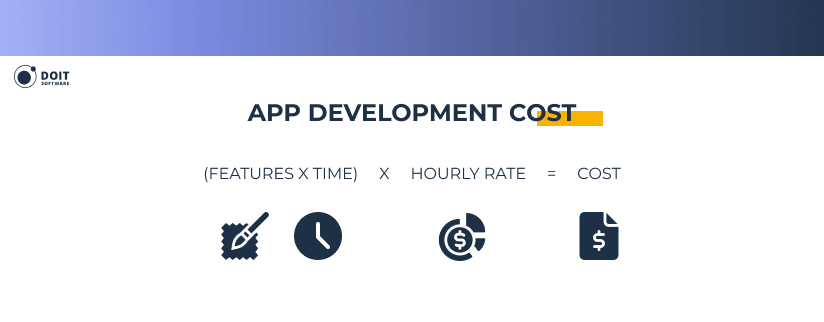
The project discovery phase helps you to be prepared for the development of your app. The aim of it is to reduce risks and minimize costs, as well as ensure that the product is technologically perfect to fit the market.
The discovery phase for the food delivery app will take about 3-4 weeks and will have a budget of 8,000-9,000 USD.
Project init
32 - 35
Detailed description of the main features' logic
12 - 15
Mind map creation
8 - 10
Clickable prototype creation
87 - 100
Solution architecture document
21 - 25
Functional requirements described in a user-story format
32 - 35
SRS - software requirements specification
8 - 10
Proto test
4 - 6
Resources & communication plan
2 - 4
Accurate estimation
10 - 12
Communication, brainstormings
35 - 38
Total, development team hours
251 - 290
Here you can choose between native and cross-platform app development. For API development the DOIT Software team suggests using Node.js.
Based on our experience, both native iOS and Android development takes up from 560 to 650 development hours total.
#2 Cross-platform app development
The entire food delivery app development process with Flutter for both iOS and Android lasts from 470 to 550 development hours.
Loading Interface
2 - 3
Location permission
6 - 9
User registration
23 - 29
User Login
14 - 16
Navigation drawer
(Menu, Orders, Profile, Support)
7 - 9
Cart view
(Salads list / Empty state)
26 - 30
Menu / Main
(category filtering, Salads list)
48 - 57
Create a salad
(Image, Ingredients, Total, Add to cart)
34 - 38
Salad interface
(Ingredients management, Total, Extra ingredients, Add to cart)
28 - 34
Ordering
(Salads list & Total, PickUp or Delivery
51 - 61
Order overview
16 - 19
Checkout
(choose the payment method, Order confirmation)
35 - 43
Order Tracking
(Stages with Map integration, Push notifications)
41 - 47
My Orders
26 - 29
User Profile
87 - 104
Support
(Contact block, Map integration, Chat integration)
28 - 35
Total, development team hours
472 - 563
Front-end and backend web development for an admin panel takes about 230 – 280 development hours.
Authorization
12 - 15
Dashboard / Orders
(Filtering, search, sorting)
38 - 45
Order status management
16 - 20
Edit menu
50 - 60
Cafe branches list
56 - 66
Contact data
3 - 5
Users data
(search, filtering, order history)
30 - 37
Reporting
(registered users report, Orders, qty. report)
26 - 35
Total, development team hours
231 - 283
It may take about 4-6 months for an MVP development (a food delivery app based on the Inventory Business Model). The total costs of food app development:
#1 Native food delivery app development: from $52,250 to $59,800.
#2 Cross-platform food delivery app development: $46,300 to $52,000.
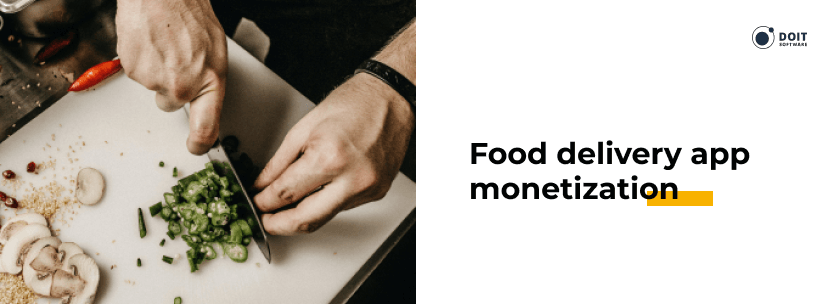
An application will not be feasible and lucrative without a clear monetization strategy. The strategy should be agreed upon during the discovery phase and proven suitable with calculations and financial projections. There are a few ways to monetize a food delivery app like Uber which we will discuss further.
Delivery fees can vary depending on the distance, time of the day, and holidays. This method is the most frequently used one for monetizing apps for delivery like Uber. Some of the fees go into the courier’s salary but the rest is a great revenue stream for any restaurant.
Like for any other application, food delivery services like GrubHub can offer in-app ads to generate additional income. You can partner up with other restaurants and publish ads for each other. Another way is by employing Google Adsense to monetize ads from Google.
SaaS applications are becoming more popular every day. You can offer free membership with standard delivery fees and a subscription-based plan that gives users some extra perks. Lower delivery fees, discounts, promos, special offers, bonuses, etc. can be great incentives for a monthly subscription fee for your customers to sign up for.
This is a method that many companies with the order and delivery model prefer, especially with an app similar to Uber Eats and/or Grubhub. If you create an aggregator app that offers services for various restaurants, you may charge a commission for every transaction only. Every new partner will bring in money from orders which will generate a stable source of income for you.
The market of on-demand food delivery app development is growing from year to year but you can go beyond this and touch on other industries as well. There are custom applications that provide medicine, alcohol, clothes, household items, and other food delivery services. Grocery delivery app development is a viable option next to medicine delivery app development, and other apps as well. On-demand apps do not have to be only about delivery: for example, you can create an appointment-making marketplace to allow users to connect with doctors, dentists, hairdressers, notaries, etc. quickly. Let’s take a look at a successful food delivery app development project from DOIT Software:
Yrgent is a healthcare application that allows patients with urgent problems to connect to medical professionals. The app offers availability checks, appointment sets, and route planning to help users get to the doctor on time. This mobile solution also helps doctors swiftly find new patients without spending money on branding and marketing. Finally, patients get a chance to browse and choose a physician that will help them by perusing reviews and comparing the ratings.
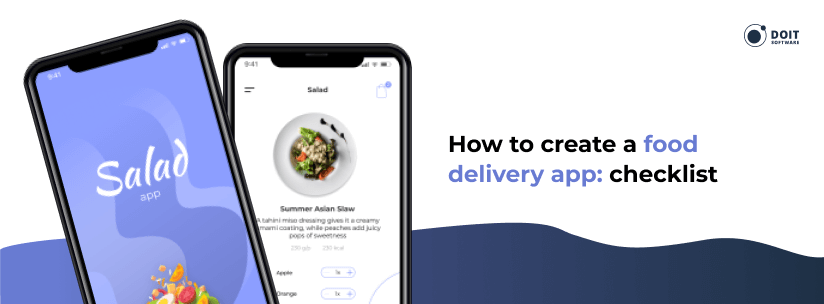
The process of food delivery app development is quite long and complicated. We have prepared a concise checklist for creating the best food delivery service.
The market for apps like Uber Eats is likely to continue evolving and growing. If you have an idea for a food delivery app for Android or iOS, it is the right time to jump on this bandwagon. And if you need some help, mobile developers from DOIT Software are here to offer their food delivery app development services. Contact DOIT Software to learn more about the food delivery app development and build your own Uber, but create it for food delivery.
Transform your idea into a successful product with the DOIT Software team.
contact usThe food delivery app development cost depends on its complexity, features, and your choice of technology.
Native food delivery app development: an MVP from $52,250 to $59,800.
Cross-platform food delivery app development: an MVP from $46,300 to $52,000.
First, learn about the business models and choose the most suitable one for you. Then you can move on to the discovery phase to research the market, users, and competitors.
Not skipping the discovery phase is one of the pillars of building a successful application. This phase helps you better understand the market and users and create a product that will cater to their needs.
Delivery service apps require four parts: client side, restaurant side, courier side, and the admin panel. Building these parts and implementing all the necessary features allows you to create a food delivery service like Uber that functions well and attracts new users.
One of the most important parts of launching successful and popular food delivery apps is identifying a product/market fit. By thoroughly researching the market and target audience you can assess how well the product will be perceived by the potential buyer.
The costs depend on the food delivery app features, the location of the vendor company, and the choice of technology. Based on our real-life example, the costs of native food delivery MVP app development lay between $52,250 to $59,800, and cross-platform development costs from $46,300 to $52,000.










